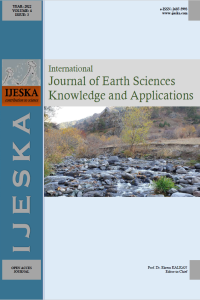Abstract
Normalized Difference Vegetation Index (NDVI) is one of the most widely used numerical indicator that uses the visible bands (VIS) and near-infrared bands (NIR) of the electromagnetic spectrum, its use as an indicator for vegetation and vegetation health based on how plants reflect certain ranges of the electromagnetic spectrum. The development of applications such as Google Earth and Microsoft Bing Maps, very high resolution (VHR) satellite imagery can be viewed over many parts of the world. The study used already created change maps based on Landsat and Aster and estimated NDVI to improve the accuracy of the data and estimate the accuracy assessment of these maps using available VHR in Google Earth. The area of the classes changed after the improvement on these maps using NDVI and the accuracy of the change maps was 0.83.
Keywords
Normalized Difference Vegetation Index (NDVI) Accuracy assessment Google Earth Response design Object-based Image analysis
References
- Cochran, W.G., 1977. Sampling Techniques (thrid edition ed.). New York: John Willey & Sons.
- FAO, 2016. Map Accuracy Assessment and Area Estimation: A Practical Guide. Retrieved from Rome.
- GFOI, 2016. Integration of remote-sensing and ground-based observations for estimation of emissions and removals of greenhouse gases in forests: Methods and Guidance from the Global Forest Observations Initiative, Edition 2.0, Food and Agriculture Organization, Rome.
- Hansen, M.C., Potapov, P.V., Moore, R., Hancher, M., Turubanova, S.A., Thau, D., Stehman, S.V., Goetz, S.J., Loveland, T.R., Kommareddy, A., Egorov, A., Chını, L., Justıce, C.O., Townshend, J.R.G., 2013. High-resolution global maps of 21st-century forest cover change. Science 342 (6160), 850-853. https://doi.org/10.1126/science.1244693.
- Olofsson, P., Foody, G.M., Herold, M., Stehman, S.V., Woodcock, C.E., Wulder, M.A., 2014. Good practices for estimating area and assessing accuracy of land change. Remote Sensing of Environment 148, 42-57.
- Saah, D., Johnson, G., Ashmall, B., Tondapu, G., Tenneson, K., Patterson, M., Poortinga, A., Markert, K., Quyen, N.H., Aung, K.S., Schlichting, L., Matin, M., Uddin, K., Aryal, R.R., Dilger, J., Ellenburg, W.L., Flores-Anderson, A.I., Wiell, D., Lindquist, E., Goldstein, J., Chishtie, F., 2019. Collect Earth: An online tool for systematic reference data collection in land cover and use applications. Environmental Modelling & Software 118, 166-171.
- Sexton, J.O., Song ,X-P., Feng, M., Noojipady, P., Anand, A., Huang, C., Kim, D-H., Collins, K.M., Channan, S., DiMiceli, C., Townshend, J.R., 2013. Global, 30-m resolution continuous fields of tree cover: landsat- based rescaling of MODIS vegetation continuous fields with lidar-based estimates of error. International Journal of Digital Earth 6 (5), 427-448. https://doi.org/10.1080/17538947.2013.786146.
- Stehman, S.V., Wickham, J.D., 2011. Pixels, blocks of pixels, and polygons: Choosing a spatial unit for thematic accuracy assessment. Remote Sensing of Environment 115 (12), 3044-3055. https://doi.org/10.1016/j.rse.2011.06.007.
Details
| Primary Language | English |
|---|---|
| Subjects | Geological Sciences and Engineering (Other) |
| Journal Section | Research Article |
| Authors | |
| Publication Date | December 30, 2022 |
| Published in Issue | Year 2022 Volume: 4 Issue: 3 |


